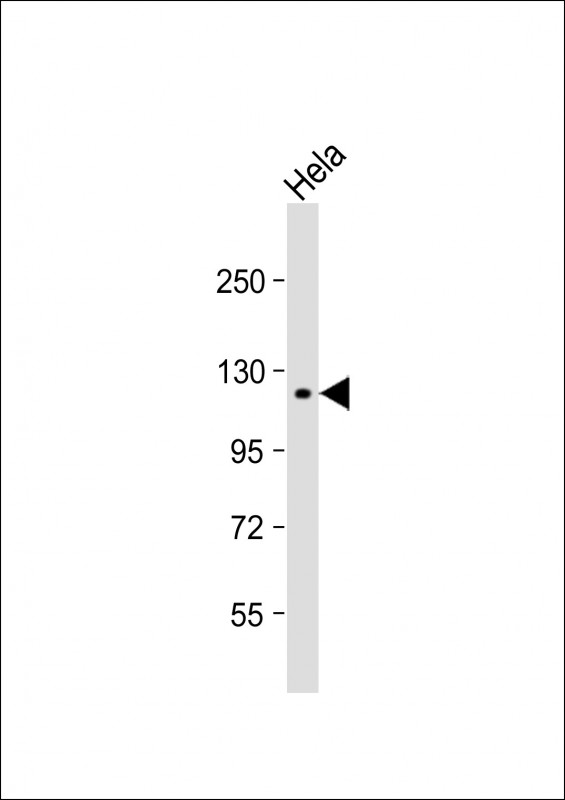SNX13 Antibody (C-term)
Affinity Purified Rabbit Polyclonal Antibody (Pab)
- SPECIFICATION
- CITATIONS: 1
- PROTOCOLS
- BACKGROUND

Application
| WB, E |
|---|---|
| Primary Accession | Q9Y5W8 |
| Other Accession | Q6PHS6, NP_055947.1 |
| Reactivity | Human |
| Predicted | Mouse |
| Host | Rabbit |
| Clonality | Polyclonal |
| Isotype | Rabbit IgG |
| Calculated MW | 112189 Da |
| Antigen Region | 780-807 aa |
| Gene ID | 23161 |
|---|---|
| Other Names | Sorting nexin-13, RGS domain- and PHOX domain-containing protein, RGS-PX1, SNX13, KIAA0713 |
| Target/Specificity | This SNX13 antibody is generated from rabbits immunized with a KLH conjugated synthetic peptide between 780-807 amino acids from the C-terminal region of human SNX13. |
| Dilution | WB~~1:1000 E~~Use at an assay dependent concentration. |
| Format | Purified polyclonal antibody supplied in PBS with 0.09% (W/V) sodium azide. This antibody is purified through a protein A column, followed by peptide affinity purification. |
| Storage | Maintain refrigerated at 2-8°C for up to 2 weeks. For long term storage store at -20°C in small aliquots to prevent freeze-thaw cycles. |
| Precautions | SNX13 Antibody (C-term) is for research use only and not for use in diagnostic or therapeutic procedures. |
| Name | SNX13 |
|---|---|
| Synonyms | KIAA0713 |
| Function | May be involved in several stages of intracellular trafficking. May play a role in endosome homeostasis (By similarity). Acts as a GAP for Galphas. |
| Cellular Location | Early endosome membrane; Peripheral membrane protein; Cytoplasmic side |

Provided below are standard protocols that you may find useful for product applications.
Background
This gene encodes a PHOX domain- and RGS domain-containing protein that belongs to the sorting nexin (SNX) family and the regulator of G protein signaling (RGS) family. The PHOX domain is a phosphoinositide binding domain, and the SNX family members are involved in intracellular trafficking. The RGS family members are regulatory molecules that act as GTPase activating proteins for G alpha subunits of heterotrimeric G proteins. The RGS domain of this protein interacts with G alpha(s), accelerates its GTP hydrolysis, and attenuates G alpha(s)-mediated signaling. Overexpression of this protein delayes lysosomal degradation of the epidermal growth factor receptor. Because of its bifunctional role, this protein may link heterotrimeric G protein signaling and vesicular trafficking.
References
Rose, J. Phd, et al. Mol. Med. (2010) In press :
Hillman, R.T., et al. Genome Biol. 5 (2), R8 (2004) :
Worby, C.A., et al. Nat. Rev. Mol. Cell Biol. 3(12):919-931(2002)
Kosan, C., et al. Cytogenet. Genome Res. 97 (3-4), 167-170 (2002) :
Zheng, B., et al. Science 294(5548):1939-1942(2001)
If you have used an Abcepta product and would like to share how it has performed, please click on the "Submit Review" button and provide the requested information. Our staff will examine and post your review and contact you if needed.
If you have any additional inquiries please email technical services at tech@abcepta.com.














 Foundational characteristics of cancer include proliferation, angiogenesis, migration, evasion of apoptosis, and cellular immortality. Find key markers for these cellular processes and antibodies to detect them.
Foundational characteristics of cancer include proliferation, angiogenesis, migration, evasion of apoptosis, and cellular immortality. Find key markers for these cellular processes and antibodies to detect them. The SUMOplot™ Analysis Program predicts and scores sumoylation sites in your protein. SUMOylation is a post-translational modification involved in various cellular processes, such as nuclear-cytosolic transport, transcriptional regulation, apoptosis, protein stability, response to stress, and progression through the cell cycle.
The SUMOplot™ Analysis Program predicts and scores sumoylation sites in your protein. SUMOylation is a post-translational modification involved in various cellular processes, such as nuclear-cytosolic transport, transcriptional regulation, apoptosis, protein stability, response to stress, and progression through the cell cycle. The Autophagy Receptor Motif Plotter predicts and scores autophagy receptor binding sites in your protein. Identifying proteins connected to this pathway is critical to understanding the role of autophagy in physiological as well as pathological processes such as development, differentiation, neurodegenerative diseases, stress, infection, and cancer.
The Autophagy Receptor Motif Plotter predicts and scores autophagy receptor binding sites in your protein. Identifying proteins connected to this pathway is critical to understanding the role of autophagy in physiological as well as pathological processes such as development, differentiation, neurodegenerative diseases, stress, infection, and cancer.

